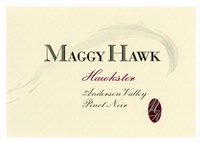|
|
 |

 Maggy Hawk, Anderson Valley (California) Pinot Noir “Hawkster” 2012 ($66): I’m never surprised to discover a type of wine that I never heard of before, let alone a brand of wine that’s new to me. My most recent lesson in humility occurred when I encountered the Maggy Hawk Pinot Noirs from Anderson Valley, four wines sourced from the same vineyard that share a family resemblance of gentleness and balance--but are nevertheless singular expressions of Pinot Noir. Maggy Hawk, Anderson Valley (California) Pinot Noir “Hawkster” 2012 ($66): I’m never surprised to discover a type of wine that I never heard of before, let alone a brand of wine that’s new to me. My most recent lesson in humility occurred when I encountered the Maggy Hawk Pinot Noirs from Anderson Valley, four wines sourced from the same vineyard that share a family resemblance of gentleness and balance--but are nevertheless singular expressions of Pinot Noir.
The Maggy Hawk vineyard is situated in the western part of Mendocino County’s Anderson Valley, where it is one of the vineyards closest to the Pacific Ocean, at the cool end of a cool region. Barbara Banke is the owner, and Maggy Hawk is the name of one of her favorite racehorses. Each of the Pinot Noir wines grown there carries the name of one of Maggy Hawk’s offspring, or in one case that of her sire, Hawkster. All the wines are priced at $66.
So much for the marketing concept. In viticultural terms, the Maggy Hawk property is a patchwork of slopes deliberately planted with different vine orientations and different clones. Each wine comes from a single vineyard block that is planted to a single clone of Pinot Noir. Five vineyard blocks exist, but in the 2012 vintage, only four of them made wine. To taste the four 2012 wines and fathom the characteristics of each separate clone is a fascinating experience.
Although significant differences exist among the four wines in terms of their weights, their aromas and their tannin structures, they share intensity of aroma, soft and silky texture and general charm. These are pretty Pinot Noirs, even if descriptors such as “rich” or “brooding” might apply to some of them.
The prettiest of the four wines is the aptly-named Jolie. This wine comes from clone 115, a Dijon clone that’s popular in California. Aromas are red fruits -- cranberry, cherry, red plum -- and floral, while flavors veer toward blue fruit and sweet spice; the wine is medium-bodied, the lightest of the four, with a creamy texture and finely-tuned acid and tannin balance.
The wine named Stormin’ is far richer than Jolie. It comes from clone 667, a dark and rather tannic variant of Pinot Noir. The wine has richness and concentration of fruit on the entry, more so than the other wines, and then soft but grippy tannins emerge to balance the lavish fruit; despite the firm acidity, this is the one wine that, in a blind tasting, I might figure to be from a warmer climate. Herbal and exotic spice notes underpin aromas of dark berries and flavors of purple plums.
One of my favorites among the 2012s was Afleet, a wine from the Pommard clone, a U.C. Davis (UCD) selection. The spiciness of this wine appealed to me -- not only spicy aromas and flavors mixed with leather and tea, but also a spiciness or edginess of structure, thanks to the wine’s firm acidity and marked tannin. Production is small because this plot is only 1.23 acres in size; in 2012, only 156 cases were produced.
My favorite was Hawkster, named for the sire and made from UCD clone 2A. This is the fullest of the four Pinots, with dark, rich aromas and flavors that include black cherry, mocha, earthiness and bramble fruit. But the wine does not taste heavy because it expresses a quiet energy in the mouth, which seems to light the wine from within. Compared to Stormin’, the other rich wine, it is more complex and compact. Although delicious now, this wine in particular seems built to age. Along with Jolie, it saw the most new oak, more than 60 percent; the other two Pinots saw more than 40 percent new oak.
All of these wines make for provocative tasting, and especially as a group. I look forward to meeting these characters again, and experiencing the wines through the prism of future vintages.
“Hawkster,” 91 Points
|
 |
|